The Cambridge History of Japan, Vol. 3: Medieval Japan
Подождите немного. Документ загружается.

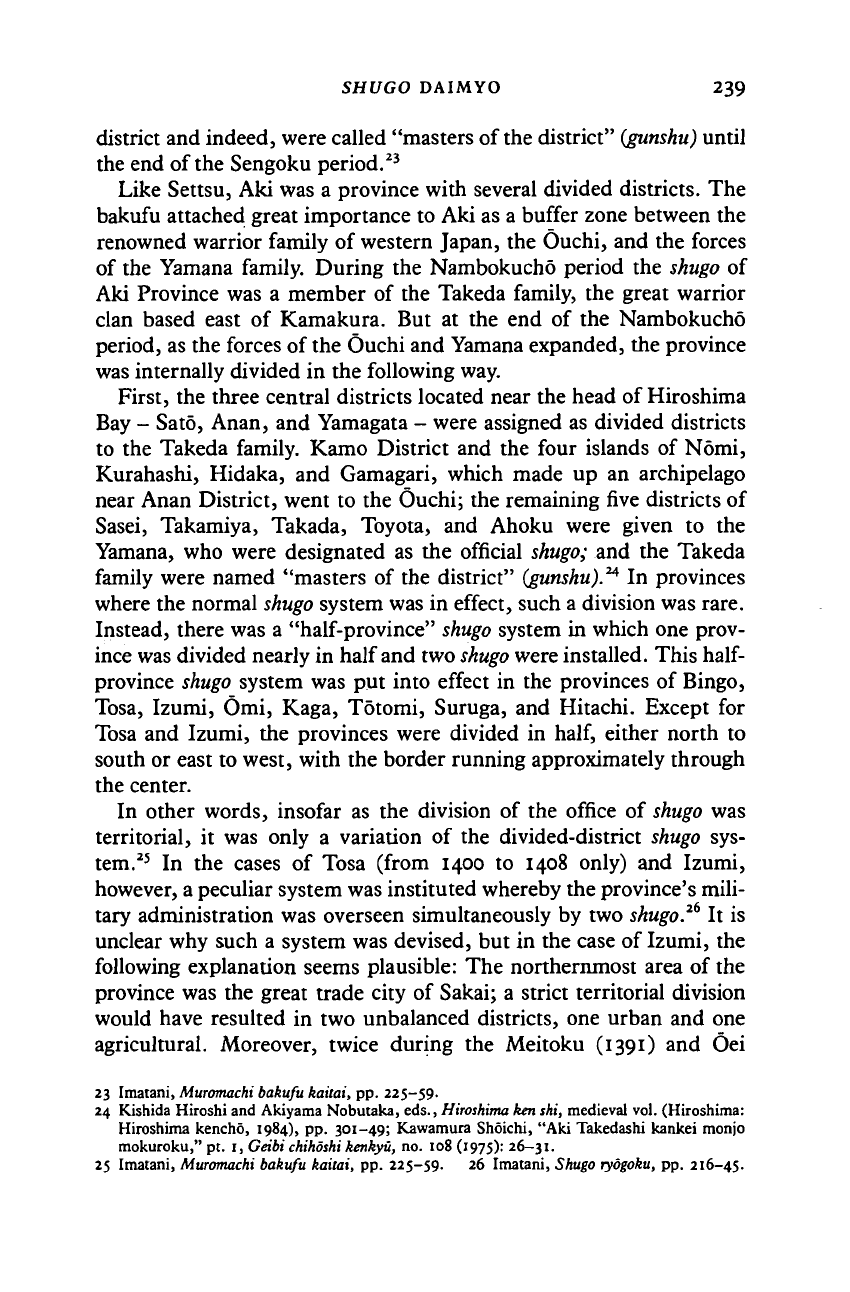
SHUGO DAIMYO
239
district
and
indeed, were called "masters
of
the district" (gunshu) until
the
end of
the Sengoku period.
23
Like Settsu,
Aki was a
province with several divided districts.
The
bakufu attached great importance
to Aki as a
buffer zone between
the
renowned warrior family
of
western Japan,
the
Ouchi,
and the
forces
of
the
Yamana family. During
the
Nambokucho period
the
shugo
of
Aki Province
was a
member
of the
Takeda family,
the
great warrior
clan based east
of
Kamakura.
But at the end of the
Nambokucho
period,
as the
forces
of
the Ouchi
and
Yamana expanded,
the
province
was internally divided
in the
following
way.
First,
the
three central districts located near
the
head
of
Hiroshima
Bay
-
Sato, Anan,
and
Yamagata
-
were assigned
as
divided districts
to
the
Takeda family. Kamo District
and the
four islands
of
Nomi,
Kurahashi, Hidaka,
and
Gamagari, which made
up an
archipelago
near Anan District, went
to the
Ouchi;
the
remaining five districts
of
Sasei, Takamiya, Takada, Toyota,
and
Ahoku were given
to the
Yamana,
who
were designated
as the
official shugo;
and the
Takeda
family were named "masters
of the
district" (gunshu).
24
In
provinces
where
the
normal shugo system
was in
effect, such
a
division
was
rare.
Instead, there
was a
"half-province" shugo system
in
which
one
prov-
ince was divided nearly
in
half and two
shugo
were installed. This
half-
province shugo system
was put
into effect
in the
provinces
of
Bingo,
Tosa, Izumi,
Omi,
Kaga, Totomi, Suruga,
and
Hitachi. Except
for
Tosa
and
Izumi,
the
provinces were divided
in half,
either north
to
south
or
east
to
west, with
the
border running approximately through
the center.
In other words, insofar
as the
division
of the
office
of
shugo
was
territorial,
it was
only
a
variation
of the
divided-district shugo
sys-
tem.
25
In the
cases
of
Tosa (from
1400 to 1408
only)
and
Izumi,
however,
a
peculiar system was instituted whereby
the
province's mili-
tary administration
was
overseen simultaneously
by two
shugo.
26
It is
unclear
why
such
a
system
was
devised,
but in the
case
of
Izumi,
the
following explanation seems plausible:
The
northernmost area
of the
province
was the
great trade city
of
Sakai;
a
strict territorial division
would have resulted
in two
unbalanced districts,
one
urban
and one
agricultural. Moreover, twice during
the
Meitoku (1391)
and Oei
23 Imatani,
Muromachi
bakufu kaitai,
pp.
225-59.
24 Kishida Hiroshi
and
Akiyama Nobutaka,
eds.,
Hiroshima
ken shi, medieval
vol.
(Hiroshima:
Hiroshima kencho, 1984),
pp.
301-49; Kawamura Shoichi,
"Aki
Takedashi kankei monjo
mokuroku,"
pt. 1,
Geibi
chihoshi
kenkyu,
no. 108
(1975):
26-31.
25 Imatani,
Muromachi
bakufu kaitai,
pp.
225-59.
26
Imatani, Shugo
ryogoku,
pp.
216-45.
Cambridge Histories Online © Cambridge University Press, 2008
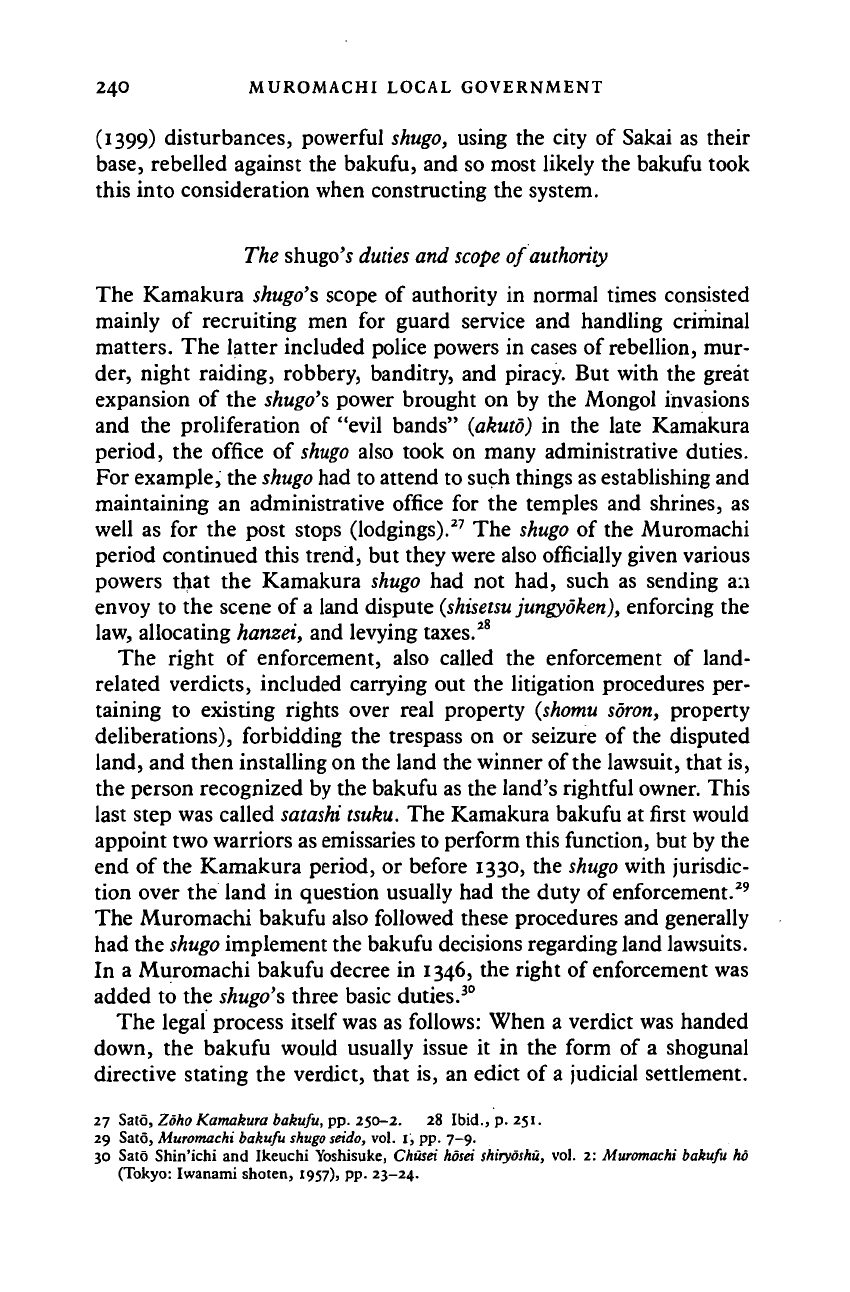
240 MUROMACHI LOCAL GOVERNMENT
(1399) disturbances, powerful
shugo,
using the city of Sakai as their
base,
rebelled against the bakufu, and so most likely the bakufu took
this into consideration when constructing the system.
The shugo's duties and
scope
of authority
The Kamakura
shugo's
scope of authority in normal times consisted
mainly of recruiting men for guard service and handling criminal
matters. The latter included police powers in cases of rebellion, mur-
der, night raiding, robbery, banditry, and piracy. But with the great
expansion of the
shugo's
power brought on by the Mongol invasions
and the proliferation of "evil bands" (akuto) in the late Kamakura
period, the office of
shugo
also took on many administrative duties.
For example, the
shugo
had to attend to such things as establishing and
maintaining an administrative office for the temples and shrines, as
well as for the post stops (lodgings).
27
The
shugo
of the Muromachi
period continued this trend, but they were also officially given various
powers that the Kamakura
shugo
had not had, such as sending an
envoy to the scene of
a
land dispute
(shisetsu
jungyoken),
enforcing the
law, allocating
hanzei,
and levying taxes.
28
The right of enforcement, also called the enforcement of land-
related verdicts, included carrying out the litigation procedures per-
taining to existing rights over real property
(shomu
sown, property
deliberations), forbidding the trespass on or seizure of the disputed
land, and then installing on the land the winner of
the
lawsuit, that is,
the person recognized by the bakufu as the land's rightful owner. This
last step was called
satashi
tsuku.
The Kamakura bakufu at first would
appoint two warriors as emissaries to perform this function, but by the
end of the Kamakura period, or before 1330, the
shugo
with jurisdic-
tion over the land in question usually had the duty of enforcement.
29
The Muromachi bakufu also followed these procedures and generally
had the
shugo
implement the bakufu decisions regarding land lawsuits.
In a Muromachi bakufu decree in 1346, the right of enforcement was
added to the
shugo's
three basic duties.
30
The legal process itself was as follows: When a verdict was handed
down, the bakufu would usually issue it in the form of a shogunal
directive stating the verdict, that is, an edict of a judicial settlement.
27 Sato, ZdhoKamakura bakufu, pp. 250-2. 28 Ibid., p. 251.
29 Sato, Muromachi bakufu
shugo
seido,
vol. I, pp. 7-9.
30 Sato Shin'ichi and Ikeuchi Yoshisuke, Chusei hosei
shiryoshu,
vol. 2: Muromachi bakufu ho
(Tokyo: Iwanami shoten, 1957), pp. 23-24.
Cambridge Histories Online © Cambridge University Press, 2008
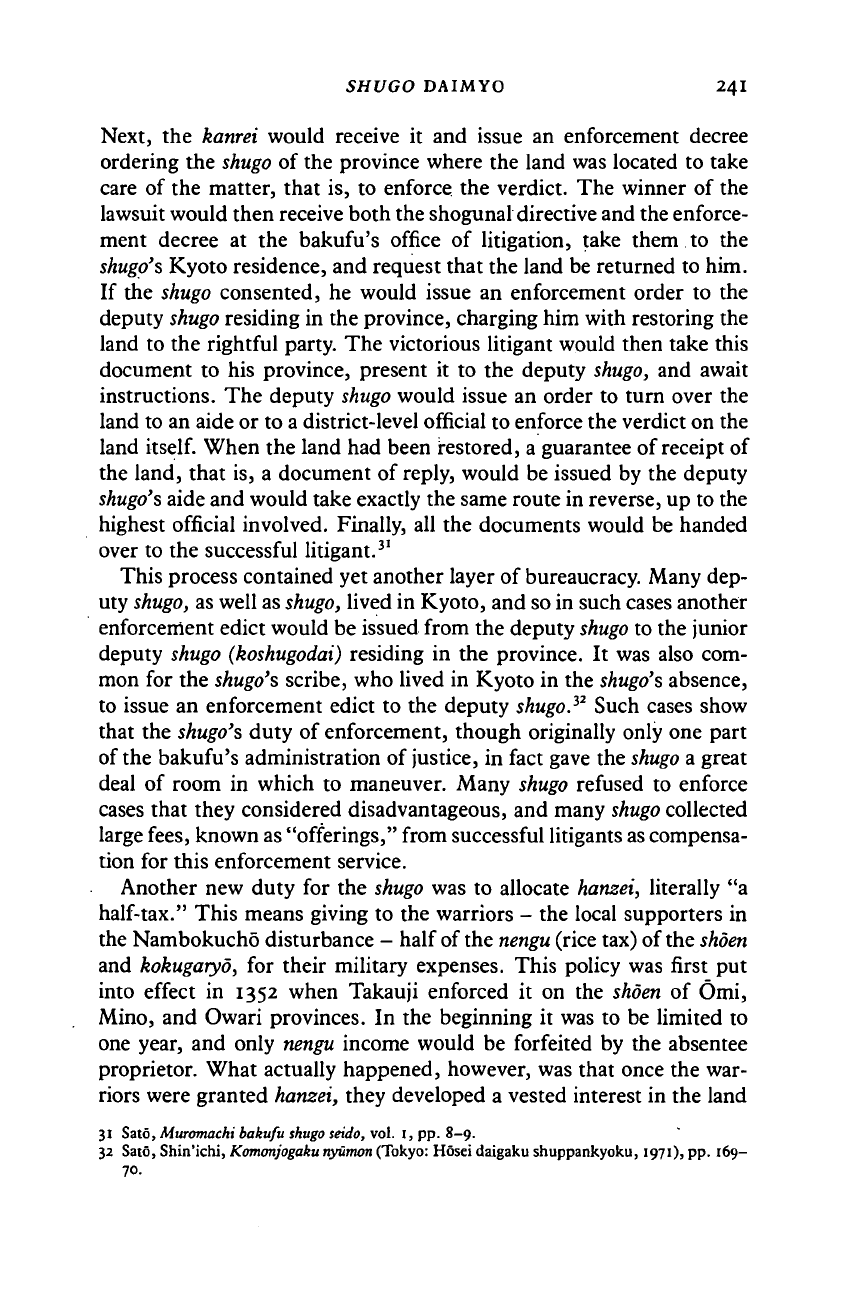
SHUGO DAIMYO 241
Next, the kanrei would receive it and issue an enforcement decree
ordering the shugo of the province where the land was located to take
care of the matter, that is, to enforce the verdict. The winner of the
lawsuit would then receive both the shogunal directive and the enforce-
ment decree at the bakufu's office of litigation, take them to the
shugo's Kyoto residence, and request that the land be returned to him.
If the shugo consented, he would issue an enforcement order to the
deputy
shugo
residing in the province, charging him with restoring the
land to the rightful party. The victorious litigant would then take this
document to his province, present it to the deputy shugo, and await
instructions. The deputy shugo would issue an order to turn over the
land to an aide or to a district-level official to enforce the verdict on the
land
itself.
When the land had been restored, a guarantee of receipt of
the land, that is, a document of reply, would be issued by the deputy
shugo's
aide and would take exactly the same route in reverse, up to the
highest official involved. Finally, all the documents would be handed
over to the successful litigant.
31
This process contained yet another layer of bureaucracy. Many dep-
uty
shugo,
as well as
shugo,
lived in Kyoto, and so in such cases another
enforcement edict would be issued from the deputy
shugo
to the junior
deputy shugo (koshugodai) residing in the province. It was also com-
mon for the shugo's scribe, who lived in Kyoto in the shugo's absence,
to issue an enforcement edict to the deputy shugo.
32
Such cases show
that the shugo's duty of enforcement, though originally only one part
of the bakufu's administration of justice, in fact gave the
shugo
a great
deal of room in which to maneuver. Many shugo refused to enforce
cases that they considered disadvantageous, and many
shugo
collected
large fees, known as "offerings," from successful litigants as compensa-
tion for this enforcement service.
Another new duty for the shugo was to allocate hanzei, literally "a
half-tax." This means giving to the warriors - the local supporters in
the Nambokucho disturbance - half of the nengu (rice tax) of the
shoen
and kokugaryo, for their military expenses. This policy was first put
into effect in 1352 when Takauji enforced it on the shoen of Omi,
Mino,
and Owari provinces. In the beginning it was to be limited to
one year, and only nengu income would be forfeited by the absentee
proprietor. What actually happened, however, was that once the war-
riors were granted hanzei, they developed a vested interest in the land
31 Sato,
Muromachi
bakufu
shugo
seido,
vol. I, pp. 8-9.
32 Sato, Shin'ichi,
Komonjogaku nyumon
(Tokyo: Hosei daigaku shuppankyoku, 1971), pp. 169-
70.
Cambridge Histories Online © Cambridge University Press, 2008
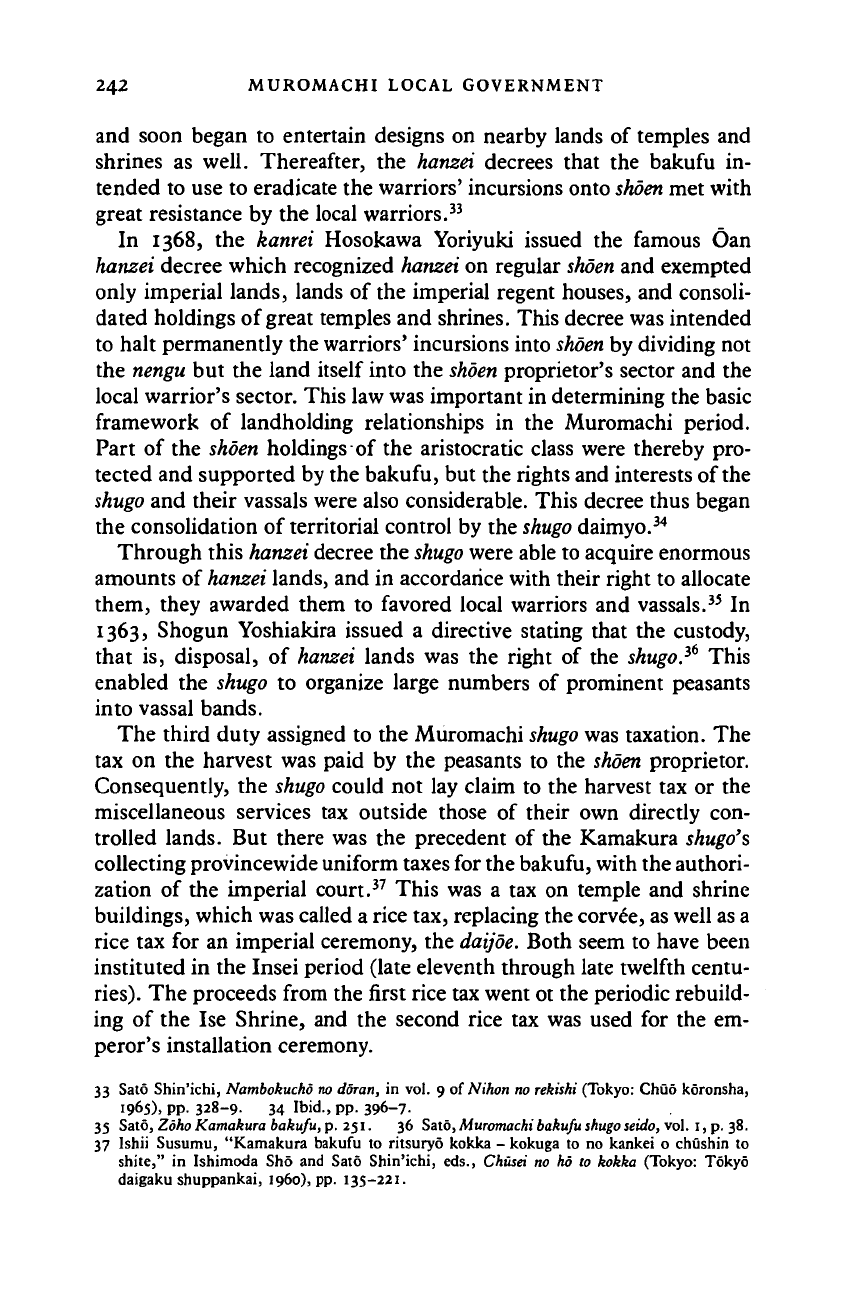
242 MUROMACHI LOCAL GOVERNMENT
and soon began to entertain designs on nearby lands of temples and
shrines as well. Thereafter, the hanzei decrees that the bakufu in-
tended to use to eradicate the warriors' incursions onto
shoen
met with
great resistance by the local warriors.
33
In 1368, the kanrei Hosokawa Yoriyuki issued the famous Can
hanzei
decree which recognized
hanzei
on regular
shoen
and exempted
only imperial lands, lands of the imperial regent houses, and consoli-
dated holdings of great temples and shrines. This decree was intended
to halt permanently the warriors' incursions into
shoen
by dividing not
the
nengu
but the land itself into the
shoen
proprietor's sector and the
local warrior's sector. This law was important in determining the basic
framework of landholding relationships in the Muromachi period.
Part of the
shoen
holdings of the aristocratic class were thereby pro-
tected and supported by the bakufu, but the rights and interests of the
shugo
and their vassals were also considerable. This decree thus began
the consolidation of territorial control by the
shugo
daimyo.
34
Through this
hanzei
decree the
shugo
were able to acquire enormous
amounts of
hanzei
lands, and in accordance with their right to allocate
them, they awarded them to favored local warriors and vassals.
35
In
1363,
Shogun Yoshiakira issued a directive stating that the custody,
that is, disposal, of
hanzei
lands was the right of the shugo.
i6
This
enabled the
shugo
to organize large numbers of prominent peasants
into vassal bands.
The third duty assigned to the Muromachi
shugo
was taxation. The
tax on the harvest was paid by the peasants to the
shoen
proprietor.
Consequently, the
shugo
could not lay claim to the harvest tax or the
miscellaneous services tax outside those of their own directly con-
trolled lands. But there was the precedent of the Kamakura
shugo's
collecting provincewide uniform taxes for the bakufu, with the authori-
zation of the imperial court.
37
This was a tax on temple and shrine
buildings, which was called a rice tax, replacing the corvee, as well as a
rice tax for an imperial ceremony, the
daijoe.
Both seem to have been
instituted in the Insei period (late eleventh through late twelfth centu-
ries).
The proceeds from the first rice tax went ot the periodic rebuild-
ing of the Ise Shrine, and the second rice tax was used for the em-
peror's installation ceremony.
33 Sato Shin'ichi, Nambokucho
no
doran, in vol. 9 oiNihon no
rekishi
(Tokyo: Chuo koronsha,
1965).
PP- 328-9- 34 Ibid-, PP- 396-7-
35 Sato, Zoho Kamakura bakufu, p. 251. 36
Szxb,
Muromachi bakufu shugo
seido,
vol. 1, p. 38.
37 Ishii Susumu, "Kamakura bakufu to ritsuryo kokka - kokuga to no kankei o chushin to
shite," in Ishimoda Sho and Sato Shin'ichi, eds., Chusei no ho to kokka (Tokyo: Tokyo
daigaku shuppankai, i960), pp. 135-221.
Cambridge Histories Online © Cambridge University Press, 2008
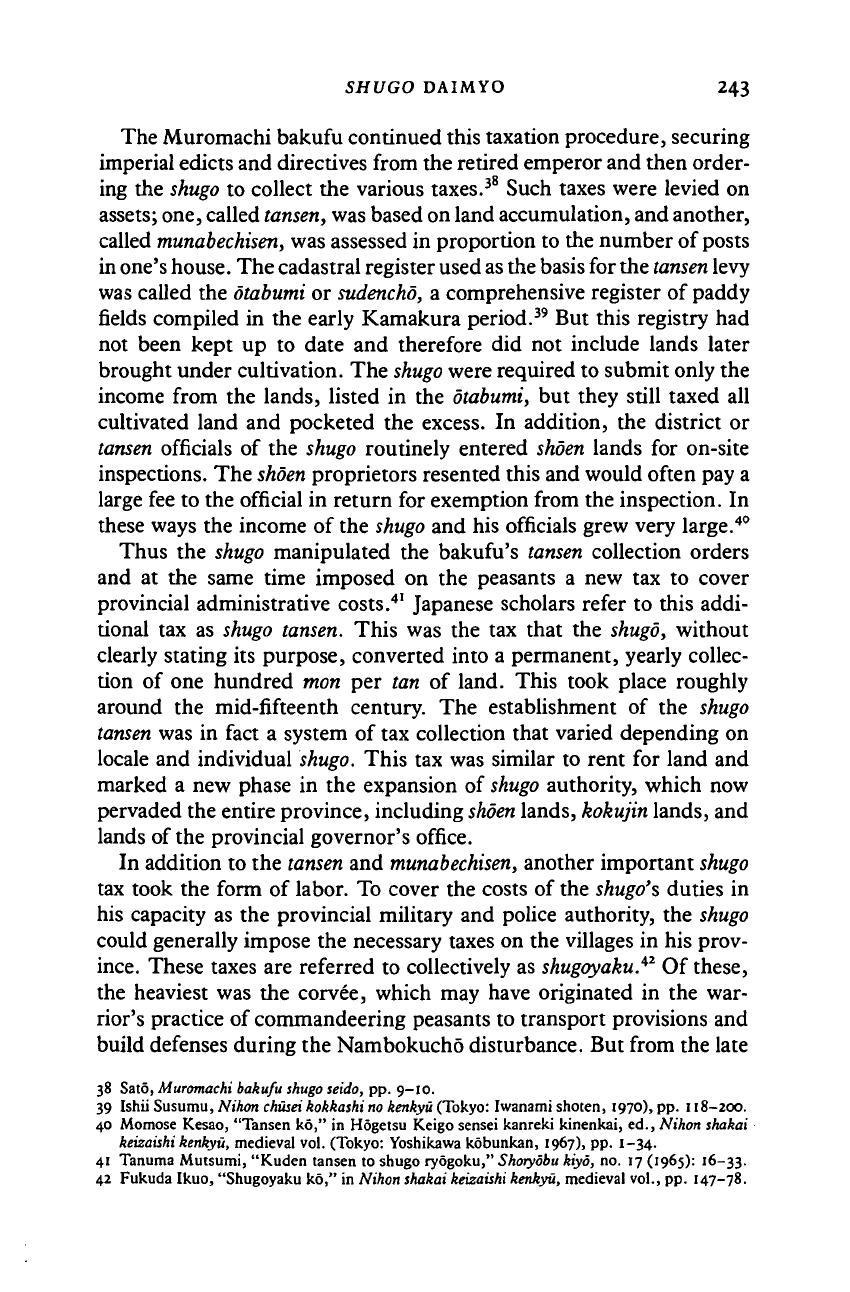
SHUGO DAIMYO 243
The Muromachi bakufu continued this taxation procedure, securing
imperial edicts and directives from the retired emperor and then order-
ing the shugo to collect the various taxes.
38
Such taxes were levied on
assets;
one, called tansen, was based on land accumulation, and another,
called
munabechisen,
was assessed in proportion to the number of posts
in one's house. The cadastral register used as the basis for the
tansen
levy
was called the otabumi or
sudencho,
a comprehensive register of paddy
fields compiled in the early Kamakura period.
39
But this registry had
not been kept up to date and therefore did not include lands later
brought under cultivation. The
shugo
were required to submit only the
income from the lands, listed in the otabumi, but they still taxed all
cultivated land and pocketed the excess. In addition, the district or
tansen officials of the shugo routinely entered shoen lands for on-site
inspections. The
shoen
proprietors resented this and would often pay a
large fee to the official in return for exemption from the inspection. In
these ways the income of the shugo and his officials grew very large.
40
Thus the shugo manipulated the bakufu's tansen collection orders
and at the same time imposed on the peasants a new tax to cover
provincial administrative costs.
41
Japanese scholars refer to this addi-
tional tax as shugo tansen. This was the tax that the shugo, without
clearly stating its purpose, converted into a permanent, yearly collec-
tion of one hundred mon per tan of land. This took place roughly
around the mid-fifteenth century. The establishment of the shugo
tansen was in fact a system of tax collection that varied depending on
locale and individual shugo. This tax was similar to rent for land and
marked a new phase in the expansion of
shugo
authority, which now
pervaded the entire province, including
shoen
lands, kokujin lands, and
lands of the provincial governor's office.
In addition to the tansen and
munabechisen,
another important shugo
tax took the form of labor. To cover the costs of the shugo's duties in
his capacity as the provincial military and police authority, the shugo
could generally impose the necessary taxes on the villages in his prov-
ince.
These taxes are referred to collectively as shugoyaku.*
2
Of these,
the heaviest was the corvee, which may have originated in the war-
rior's practice of commandeering peasants to transport provisions and
build defenses during the Nambokucho disturbance. But from the late
38 Sato, Muromachi bakufu shugo seido, pp. 9—10.
39 Ishii Susumu, Nihon
chusei
kokkashi no kenkyu (Tokyo: Iwanami shoten, 1970), pp. 118-200.
40 Momose Kesao, "Tansen ko," in Hogetsu Keigo sensei kanreki kinenkai, ed., Nihon shakai
keizaishi kenkyu, medieval vol. (Tokyo: Yoshikawa kobunkan, 1967), pp. 1-34.
41 Tanuma Mutsumi, "Kuden tansen to shugo ryogoku," Shoryobu kiyo, no. 17 (1965):
16-33.
42 Fukuda Ikuo, "Shugoyaku ko," in Nihon shakai keizaishi kenkyu, medieval vol., pp. 147-78.
Cambridge Histories Online © Cambridge University Press, 2008
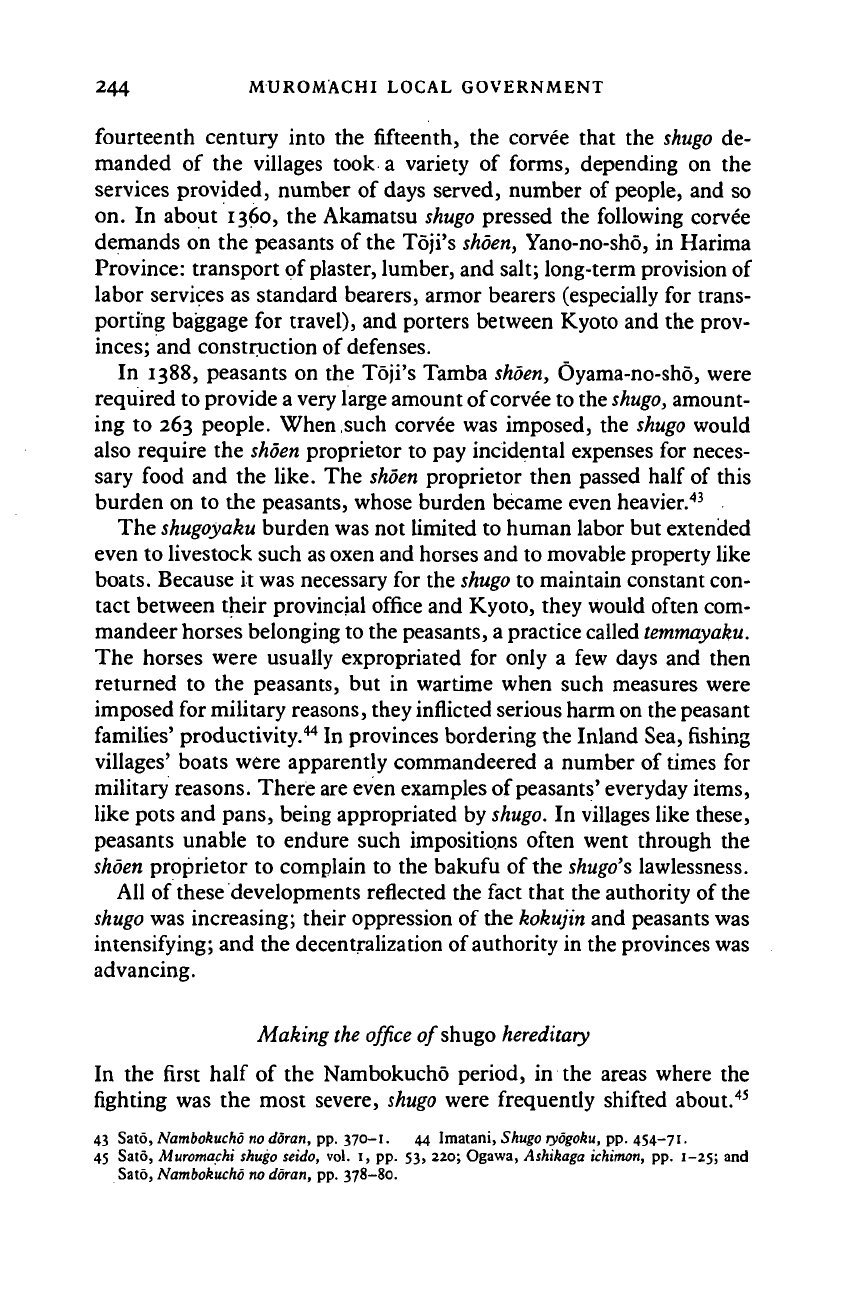
244 MUROMACHI LOCAL GOVERNMENT
fourteenth century into the fifteenth, the corvee that the
shugo
de-
manded of the villages took a variety of forms, depending on the
services provided, number of days served, number of people, and so
on. In about 1360, the Akamatsu
shugo
pressed the following corvee
demands on the peasants of the Toji's
shoen,
Yano-no-sho, in Harima
Province: transport of plaster, lumber, and salt; long-term provision of
labor services as standard bearers, armor bearers (especially for trans-
porting baggage for travel), and porters between Kyoto and the prov-
inces;
and construction of defenses.
In 1388, peasants on the Toji's Tamba
shoen,
Oyama-no-sho, were
required to provide a very large amount of corvee to the
shugo,
amount-
ing to 263 people. When .such corvee was imposed, the
shugo
would
also require the
shoen
proprietor to pay incidental expenses for neces-
sary food and the like. The
shoen
proprietor then passed half of this
burden on to the peasants, whose burden became even heavier.
43
The
shugoyaku
burden was not limited to human labor but extended
even to livestock such as oxen and horses and to movable property like
boats.
Because it was necessary for the
shugo
to maintain constant con-
tact between their provincial office and Kyoto, they would often com-
mandeer horses belonging to the peasants, a practice called
temmayaku.
The horses were usually expropriated for only a few days and then
returned to the peasants, but in wartime when such measures were
imposed for military reasons, they inflicted serious harm on the peasant
families' productivity.
44
In provinces bordering the Inland Sea, fishing
villages' boats were apparently commandeered a number of times for
military reasons. There are even examples of peasants' everyday items,
like pots and pans, being appropriated by
shugo.
In villages like these,
peasants unable to endure such impositions often went through the
shoen
proprietor to complain to the bakufu of the
shugo's
lawlessness.
All of these developments reflected the fact that the authority of the
shugo
was increasing; their oppression of the
kokujin
and peasants was
intensifying; and the decentralization of authority in the provinces was
advancing.
Making the
office
of shugo
hereditary
In the first half of the Nambokucho period, in the areas where the
fighting was the most severe,
shugo
were frequently shifted about.
45
43 Sato, Nambokucho no doran, pp.
370-1.
44 Imatani, Shugo ryogoku, pp.
454-71.
45 Sato, Muromachi shugo seido, vol. 1, pp. 53, 220; Ogawa, Ashikaga ichimon, pp. 1-25; and
Sato,
Nambokucho no doran, pp. 378-80.
Cambridge Histories Online © Cambridge University Press, 2008
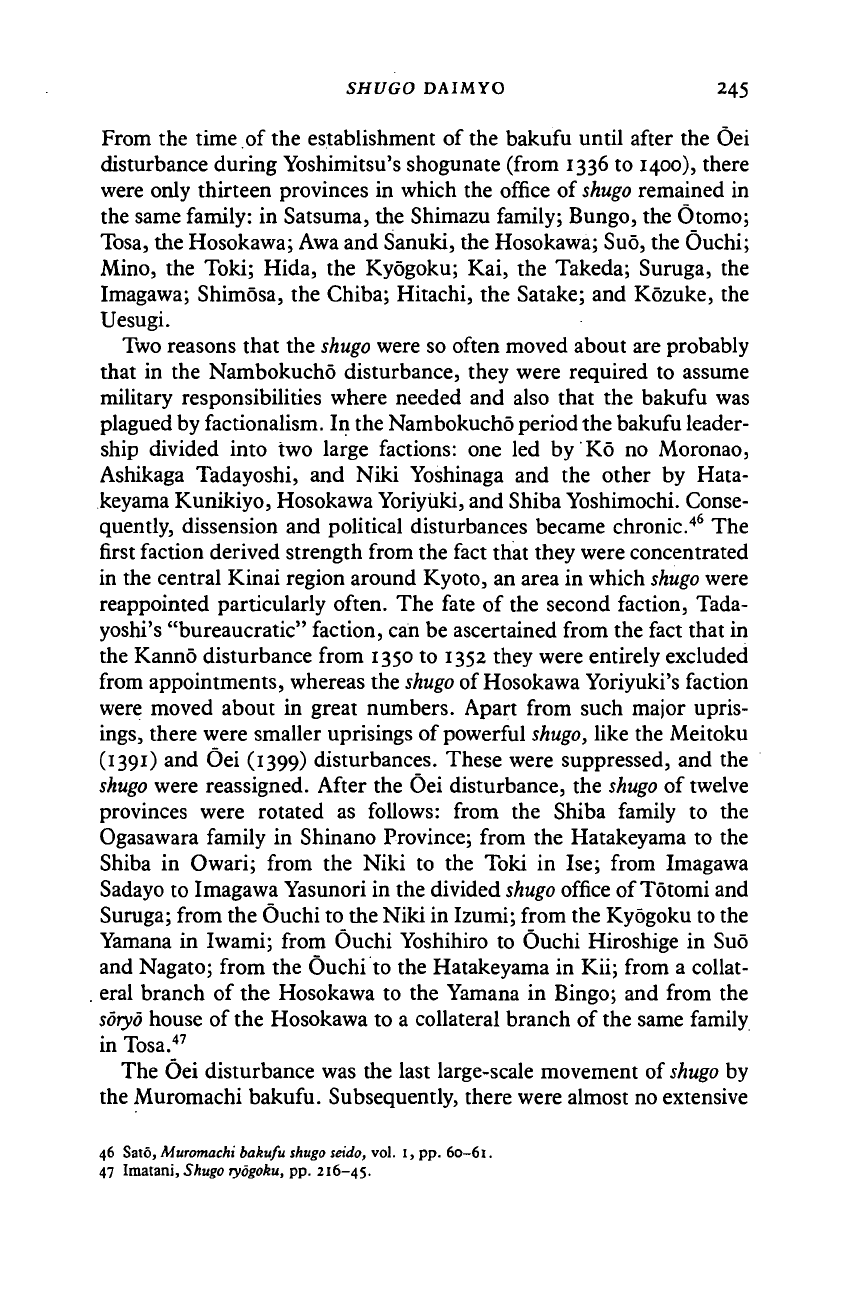
SHUGO DAIMYO 245
From the time of the establishment of the bakufu until after the Oei
disturbance during Yoshimitsu's shogunate (from 1336 to 1400), there
were only thirteen provinces in which the office of
shugo
remained in
the same family: in Satsuma, the Shimazu family; Bungo, the Otomo;
Tosa, the Hosokawa; Awa and Sanuki, the Hosokawa; Suo, the Ouchi;
Mino,
the Toki; Hida, the Kyogoku; Kai, the Takeda; Suruga, the
Imagawa; Shimosa, the Chiba; Hitachi, the Satake; and Kozuke, the
Uesugi.
Two reasons that the
shugo
were so often moved about are probably
that in the Nambokucho disturbance, they were required to assume
military responsibilities where needed and also that the bakufu was
plagued by factionalism. In the Nambokucho period the bakufu leader-
ship divided into two large factions: one led by K6 no Moronao,
Ashikaga Tadayoshi, and Niki Yoshinaga and the other by Hata-
keyama Kunikiyo, Hosokawa Yoriyiiki, and Shiba Yoshimochi. Conse-
quently, dissension and political disturbances became chronic.
46
The
first faction derived strength from the fact that they were concentrated
in the central Kinai region around Kyoto, an area in which
shugo
were
reappointed particularly often. The fate of the second faction, Tada-
yoshi's "bureaucratic" faction, can be ascertained from the fact that in
the Kanno disturbance from 1350 to 1352 they were entirely excluded
from appointments, whereas the
shugo
of Hosokawa Yoriyuki's faction
were moved about in great numbers. Apart from such major upris-
ings,
there were smaller uprisings of powerful shugo, like the Meitoku
(1391) and Oei (1399) disturbances. These were suppressed, and the
shugo
were reassigned. After the Oei disturbance, the
shugo
of twelve
provinces were rotated as follows: from the Shiba family to the
Ogasawara family in Shinano Province; from the Hatakeyama to the
Shiba in Owari; from the Niki to the Toki in Ise; from Imagawa
Sadayo to Imagawa Yasunori in the divided
shugo
office of Totomi and
Suruga; from the Ouchi to the Niki in Izumi; from the Kyogoku to the
Yamana in Iwami; from Ouchi Yoshihiro to Ouchi Hiroshige in Suo
and Nagato; from the Ouchi to the Hatakeyama in Kii; from a collat-
eral branch of the Hosokawa to the Yamana in Bingo; and from the
soryo
house of the Hosokawa to a collateral branch of the same family
in Tosa.
47
The Oei disturbance was the last large-scale movement of
shugo
by
the Muromachi bakufu. Subsequently, there were almost no extensive
46 Sato, Muromachi bakufu
shugo
seido,
vol. I, pp.
60-61.
47 Imatani, Shugo ryogoku, pp. 216-45.
Cambridge Histories Online © Cambridge University Press, 2008
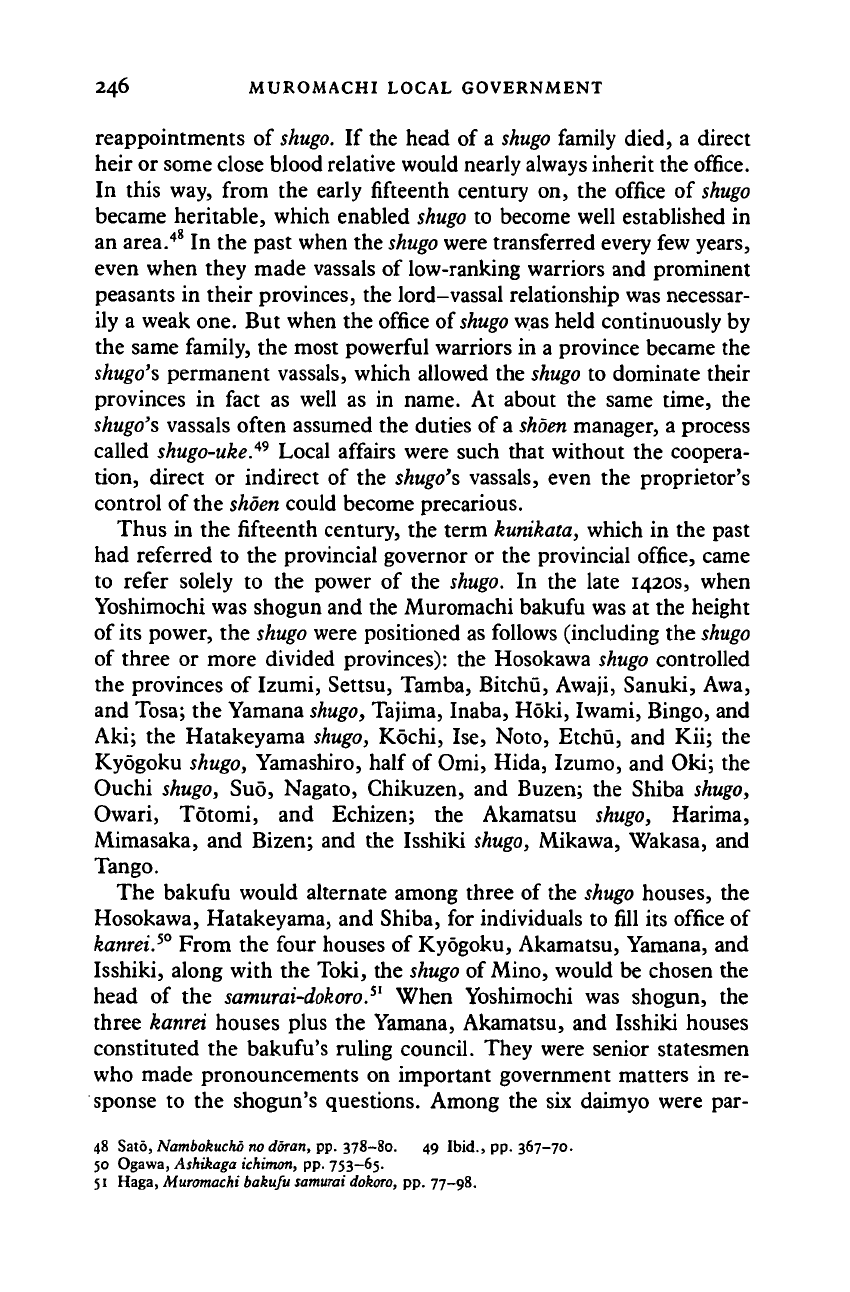
246 MUROMACHI LOCAL GOVERNMENT
reappointments of
shugo.
If the head of a
shugo
family died, a direct
heir or some close blood relative would nearly always inherit the office.
In this way, from the early fifteenth century on, the office of
shugo
became heritable, which enabled
shugo
to become well established in
an area.
48
In the past when the
shugo
were transferred every few years,
even when they made vassals of low-ranking warriors and prominent
peasants in their provinces, the lord-vassal relationship was necessar-
ily a weak one. But when the office of
shugo
was held continuously by
the same family, the most powerful warriors in a province became the
shugo's
permanent vassals, which allowed the
shugo
to dominate their
provinces in fact as well as in name. At about the same time, the
shugo's
vassals often assumed the duties of
a shoen
manager, a process
called
shugo-uke.*
9
Local affairs were such that without the coopera-
tion, direct or indirect of the
shugo's
vassals, even the proprietor's
control of the
shoen
could become precarious.
Thus in the fifteenth century, the term
kunikata,
which in the past
had referred to the provincial governor or the provincial office, came
to refer solely to the power of the
shugo.
In the late 1420s, when
Yoshimochi was shogun and the Muromachi bakufu was at the height
of its power, the
shugo
were positioned as follows (including the
shugo
of three or more divided provinces): the Hosokawa
shugo
controlled
the provinces of Izumi, Settsu, Tamba, Bitchu, Awaji, Sanuki, Awa,
and Tosa; the Yamana
shugo,
Tajima, Inaba, Hoki, Iwami, Bingo, and
Aki;
the Hatakeyama
shugo,
Kochi, Ise, Noto, Etchu, and Kii; the
Kyogoku
shugo,
Yamashiro, half of Omi, Hida, Izumo, and Oki; the
Ouchi
shugo,
Suo, Nagato, Chikuzen, and Buzen; the Shiba shugo,
Owari, Totomi, and Echizen; the Akamatsu shugo, Harima,
Mimasaka, and Bizen; and the Isshiki
shugo,
Mikawa, Wakasa, and
Tango.
The bakufu would alternate among three of the
shugo
houses, the
Hosokawa, Hatakeyama, and Shiba, for individuals to fill its office of
kanrei.
50
From the four houses of Kyogoku, Akamatsu, Yamana, and
Isshiki, along with the Toki, the
shugo
of Mino, would be chosen the
head of the
samurai-dokoro.
51
When Yoshimochi was shogun, the
three kanrei houses plus the Yamana, Akamatsu, and Isshiki houses
constituted the bakufu's ruling council. They were senior statesmen
who made pronouncements on important government matters in re-
sponse to the shogun's questions. Among the six daimyo were par-
48 Sato, Nambokucho no doran, pp. 378-80. 49 Ibid., pp. 367-70.
50 Ogawa, Ashikaga ichimon, pp. 753-65.
51 Haga, Muromachi bakufu
samurai
dokoro,
pp. 77-98.
Cambridge Histories Online © Cambridge University Press, 2008
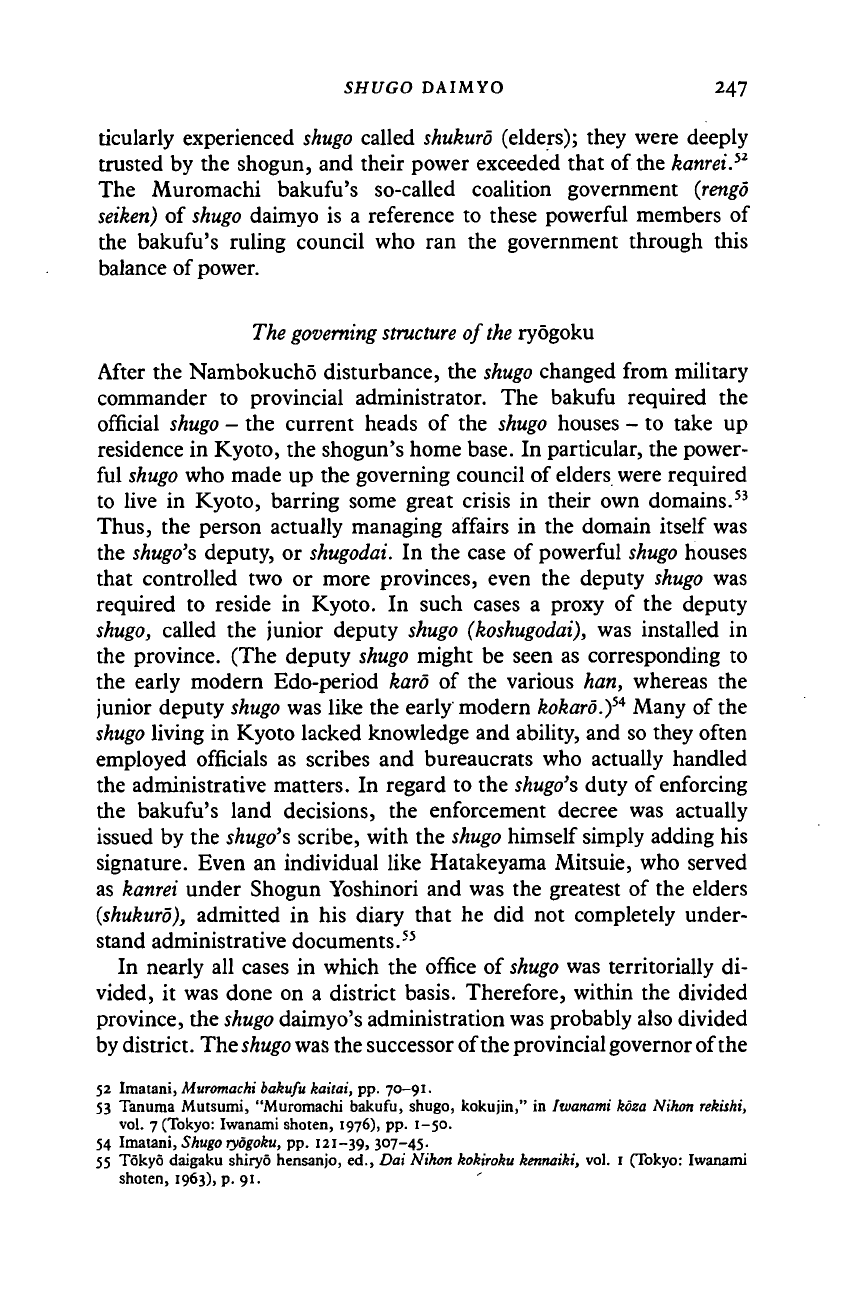
SHUGO DAIMYO 247
ticularly experienced shugo called shukuro (elders); they were deeply
trusted by the shogun, and their power exceeded that of the kanrei.
52
The Muromachi bakufu's so-called coalition government {rengo
seiken) of
shugo
daimyo is a reference to these powerful members of
the bakufu's ruling council who ran the government through this
balance of power.
The
governing structure
of the ryogoku
After the Nambokucho disturbance, the shugo changed from military
commander to provincial administrator. The bakufu required the
official shugo - the current heads of the shugo houses - to take up
residence in Kyoto, the shogun's home base. In particular, the power-
ful shugo who made up the governing council of elders were required
to live in Kyoto, barring some great crisis in their own domains.
53
Thus,
the person actually managing affairs in the domain itself was
the shugo's deputy, or shugodai. In the case of powerful shugo houses
that controlled two or more provinces, even the deputy shugo was
required to reside in Kyoto. In such cases a proxy of the deputy
shugo,
called the junior deputy shugo (koshugodai), was installed in
the province. (The deputy shugo might be seen as corresponding to
the early modern Edo-period karo of the various han, whereas the
junior deputy shugo was like the early modern kokaro.)
54
Many of the
shugo living in Kyoto lacked knowledge and ability, and so they often
employed officials as scribes and bureaucrats who actually handled
the administrative matters. In regard to the shugo's duty of enforcing
the bakufu's land decisions, the enforcement decree was actually
issued by the shugo's scribe, with the shugo himself simply adding his
signature. Even an individual like Hatakeyama Mitsuie, who served
as kanrei under Shogun Yoshinori and was the greatest of the elders
(shukuro),
admitted in his diary that he did not completely under-
stand administrative documents.
55
In nearly all cases in which the office of
shugo
was territorially di-
vided, it was done on a district basis. Therefore, within the divided
province, the
shugo
daimyo's administration was probably also divided
by district. The
shugo
was the successor of the provincial governor of the
52 Imatani,
Muromachi
bakufu kaitai, pp.
70—91.
53 Tanuma Mutsumi, "Muromachi bakufu, shugo, kokujin," in Iwanami koza Nihon rekiski,
vol. 7 (Tokyo: Iwanami shoten, 1976), pp. 1-50.
54 Imatani, Shugo
ryogoku,
pp. 121-39, 307-45.
55 Tokyo daigaku shiryo hensanjo, ed., Dai Nihon kokiroku kennaiki, vol. 1 (Tokyo: Iwanami
shoten, 1963), p. 91. '
Cambridge Histories Online © Cambridge University Press, 2008
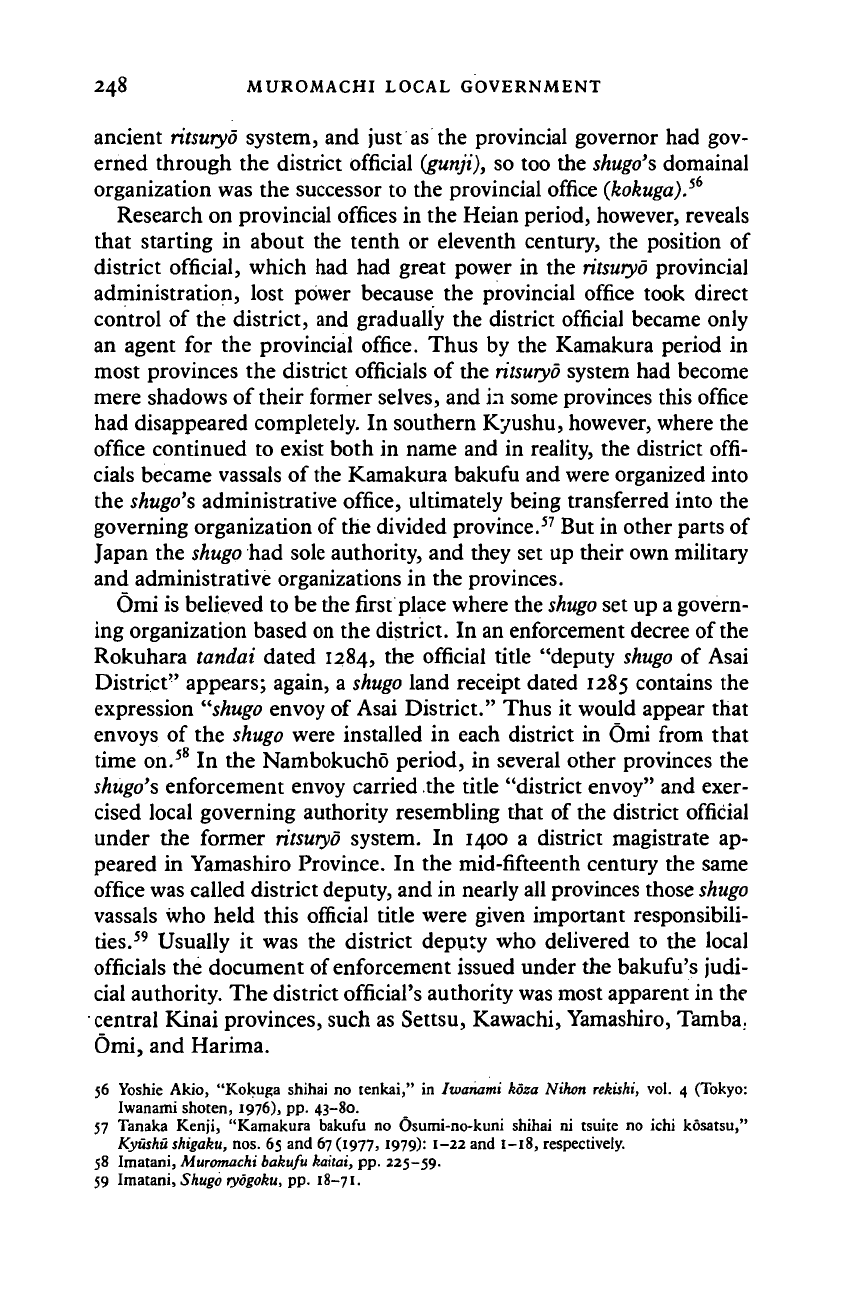
248 MUROMACHI LOCAL GOVERNMENT
ancient
ritsuryo
system, and just as the provincial governor had gov-
erned through the district official
(gunji),
so too the
shugo's
domainal
organization was the successor to the provincial office
(kokuga).
56
Research on provincial offices in the Heian period, however, reveals
that starting in about the tenth or eleventh century, the position of
district official, which had had great power in the
ritsuryo
provincial
administration, lost power because the provincial office took direct
control of the district, and gradually the district official became only
an agent for the provincial office. Thus by the Kamakura period in
most provinces the district officials of the
ritsuryo
system had become
mere shadows of their former selves, and in some provinces this office
had disappeared completely. In southern Kyushu, however, where the
office continued to exist both in name and in reality, the district offi-
cials became vassals of the Kamakura bakufu and were organized into
the
shugo's
administrative office, ultimately being transferred into the
governing organization of the divided province.
57
But in other parts of
Japan the
shugo
had sole authority, and they set up their own military
and administrative organizations in the provinces.
Omi is believed to be the first place where the
shugo
set up a govern-
ing organization based on the district. In an enforcement decree of the
Rokuhara tandai dated 1284, the official title "deputy
shugo
of Asai
District" appears; again, a
shugo
land receipt dated 1285 contains the
expression
"shugo
envoy of Asai District." Thus it would appear that
envoys of the
shugo
were installed in each district in Omi from that
time on.
58
In the Nambokucho period, in several other provinces the
shugo's
enforcement envoy carried the title "district envoy" and exer-
cised local governing authority resembling that of the district official
under the former ritsuryo system. In 1400 a district magistrate ap-
peared in Yamashiro Province. In the mid-fifteenth century the same
office was called district deputy, and in nearly all provinces those
shugo
vassals who held this official title were given important responsibili-
ties.
59
Usually it was the district deputy who delivered to the local
officials the document of enforcement issued under the bakufu's judi-
cial authority. The district official's authority was most apparent in the
central Kinai provinces, such as Settsu, Kawachi, Yamashiro, Tamba..
Omi, and Harima.
56 Yoshie Akio, "Kokuga shihai no tenkai," in Iwanami koza Nihon rekishi, vol. 4 (Tokyo:
Iwanami shoten, 1976), pp. 43-80.
57 Tanaka Kenji, "Kamakura bakufu no Osumi-no-kuni shihai ni tsuite no ichi kosatsu,"
Kyushu shigaku, nos. 65 and 67 (1977, 1979): 1-22 and 1-18, respectively.
58 Imatani, Muromachi bakufu kaitai, pp. 225-59.
59 Imatani, Shugo
ryogoku,
pp.
18-71.
Cambridge Histories Online © Cambridge University Press, 2008
